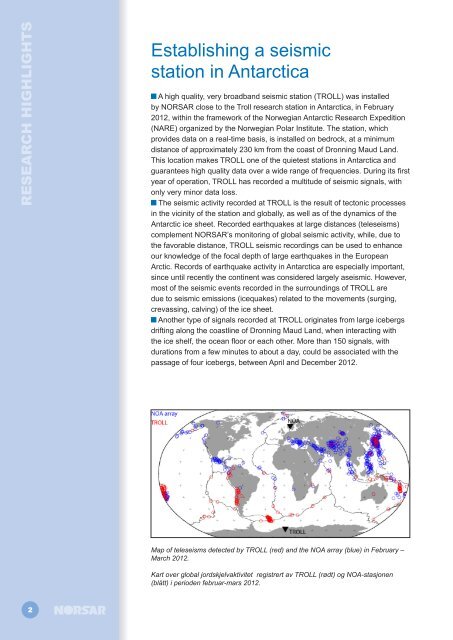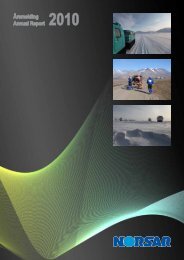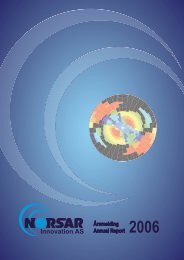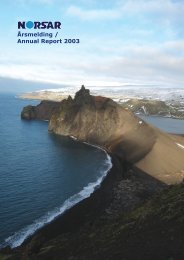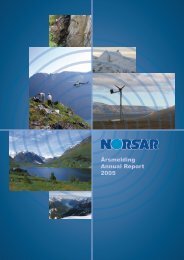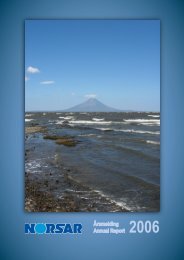NORSAR Foundation
NORSAR Foundation
NORSAR Foundation
You also want an ePaper? Increase the reach of your titles
YUMPU automatically turns print PDFs into web optimized ePapers that Google loves.
RESEARCH HIGHLIGHTS<br />
Establishing a seismic<br />
station in Antarctica<br />
A high quality, very broadband seismic station (TROLL) was installed<br />
by <strong>NORSAR</strong> close to the Troll research station in Antarctica, in February<br />
2012, within the framework of the Norwegian Antarctic Research Expedition<br />
(NARE) organized by the Norwegian Polar Institute. The station, which<br />
provides data on a real-time basis, is installed on bedrock, at a minimum<br />
distance of approximately 230 km from the coast of Dronning Maud Land.<br />
This location makes TROLL one of the quietest stations in Antarctica and<br />
guarantees high quality data over a wide range of frequencies. During its first<br />
year of operation, TROLL has recorded a multitude of seismic signals, with<br />
only very minor data loss.<br />
The seismic activity recorded at TROLL is the result of tectonic processes<br />
in the vicinity of the station and globally, as well as of the dynamics of the<br />
Antarctic ice sheet. Recorded earthquakes at large distances (teleseisms)<br />
complement <strong>NORSAR</strong>’s monitoring of global seismic activity, while, due to<br />
the favorable distance, TROLL seismic recordings can be used to enhance<br />
our knowledge of the focal depth of large earthquakes in the European<br />
Arctic. Records of earthquake activity in Antarctica are especially important,<br />
since until recently the continent was considered largely aseismic. However,<br />
most of the seismic events recorded in the surroundings of TROLL are<br />
due to seismic emissions (icequakes) related to the movements (surging,<br />
crevassing, calving) of the ice sheet.<br />
Another type of signals recorded at TROLL originates from large icebergs<br />
drifting along the coastline of Dronning Maud Land, when interacting with<br />
the ice shelf, the ocean floor or each other. More than 150 signals, with<br />
durations from a few minutes to about a day, could be associated with the<br />
passage of four icebergs, between April and December 2012.<br />
Map of teleseisms detected by TROLL (red) and the NOA array (blue) in February –<br />
March 2012.<br />
Kart over global jordskjelvaktivitet registrert av TROLL (rødt) og NOA-stasjonen<br />
(blått) i perioden februar-mars 2012.<br />
2


